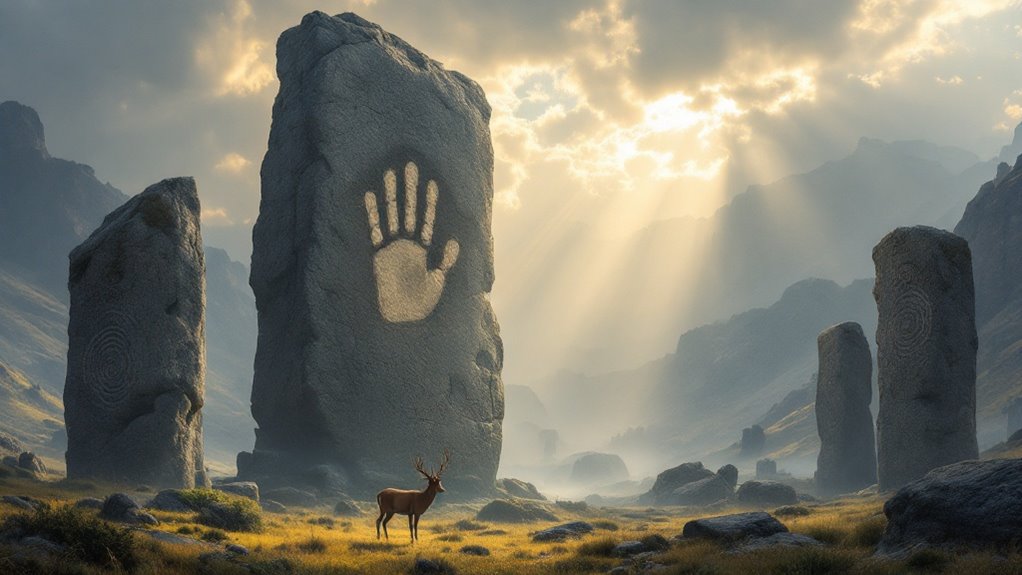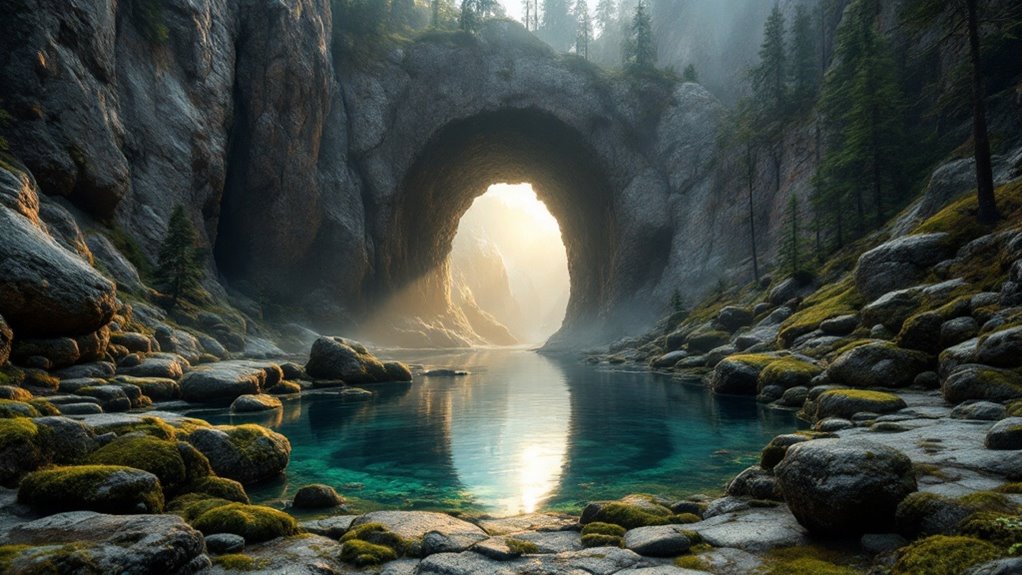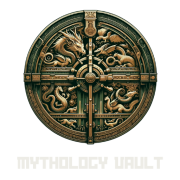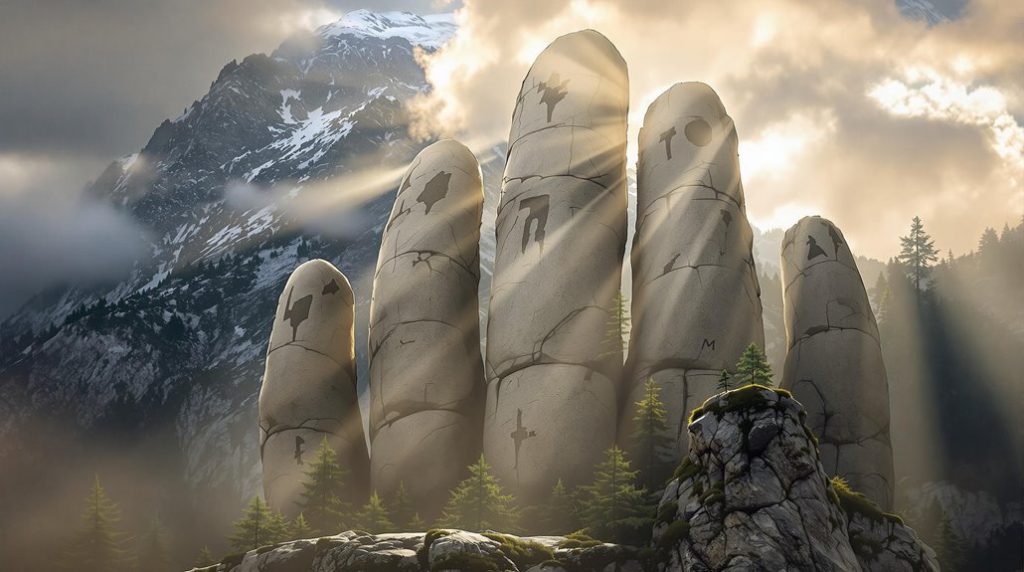I've discovered that giant mythologies reveal far more than tales of colossal beings; they expose fundamental patterns in human consciousness. When I trace these titanic figures across cultures, I find they're not merely antagonists but primal forces that bridge our earthly existence with divine domains.
From the Norse Jötnar to the Greek Gigantes, these beings embody humanity's complex relationship with power, nature, and cosmic order. What fascinates me most is how these ancient narratives mirror our modern struggles with authority and environmental stewardship. Let's explore what these towering figures can teach us about our own place in the universal story.
Origins of Ancient Giant Lore
The origins of humanity's fascination with giants can be traced back to ancient Greece, where the Gigantes emerged from Uranus's blood after his violent castration by Cronus. Initially, these beings weren't the towering behemoths we picture today – they began as man-sized warriors in Hesiod's accounts.
The evolution of the giant concept across various cultures is quite fascinating. While the Greeks referred to them as "gegeneis" (earthborn), similar beings appeared in Norse sagas, Aztec legends, and Hebrew texts as the Nephilim. According to ancient texts, these beings were born with gleaming armor and spears. What's interesting to note is how these early myths transformed over time. The Giants shifted from being depicted as normal-sized warriors to snake-legged monsters after 380 BC, marking a pivotal evolution in how ancient peoples processed ideas of power and opposition to established order.
Mightiest Battles Against The Gods
The Gigantomachy, a legendary confrontation in mythological history, was a defining cosmic battle between the Olympian gods and the mighty Giants. I find it fascinating how this clash embodies the eternal struggle between order and chaos, with Zeus's forces facing off against Gaia's children who hurled burning oaks and massive rocks at the heavens. Among their devastating attacks, the Giants moved entire mountains and rivers, reshaping the landscape in their wake.
What makes this battle particularly intriguing is its revelation of divine vulnerability. The gods couldn't achieve victory alone and needed a mortal hero, Heracles, to fulfill the prophecy. When Heracles fought alongside the Olympians, throwing Alcyoneus beyond his native land and striking down Giants with his arrows, it became a powerful metaphor: even the mightiest powers sometimes require human intervention to maintain cosmic balance.
Sacred Texts Tell Giant Tales

Sacred texts from ancient civilizations, like the Bible, contain fascinating stories about giants. From Genesis to Samuel, these narratives describe beings like the Nephilim—offspring of divine and human union—and the fearsome Anakim who made the Israelites feel tiny in comparison.
When I look at these accounts alongside other mythological traditions, I notice some striking similarities. The Biblical giant Og of Bashan, known for his massive iron bed, bears a resemblance to the imposing figures in Norse sagas. The Rephaites' descendants were later found and defeated in the city of Gath. What I find most intriguing, however, is how these stories go beyond just physical descriptions. In texts like the Book of Enoch, giants emerge as powerful symbols of chaos and rebellion. Their tales serve as warnings about the delicate balance between divine order and human ambition.
Beyond Greek Mythological Boundaries
While Greek mythology is front and center in many Western discussions about giants, I've found that these towering beings are actually a part of the mythological landscape in nearly every culture around the globe. From Africa's Yoruba giants like Obatala to China's cosmic giant Pangu, there's a fascinating pattern of enormous beings shaping our world's creation stories that I find really intriguing.
What stands out to me is how Native American traditions, like the Si-Te-Cah legends of the Paiute people, echo similar themes of ancient giant races. The Inca believed giants were the first inhabitants of Earth, while in Nigerian folklore, these colossal beings are still said to be lurking in forests and mountains. When I look at these cross-cultural patterns, I notice that giants consistently represent primal forces – whether it's Yu the Great controlling China's floods or the Aztec Quinametzin existing in previous solar eras. To me, these universal stories reveal humanity's shared understanding of power beyond mortal scale in a really profound way.
Legacy Through The Ages

The enduring presence of mythical giants across civilizations is a fascinating aspect of human culture. From the Greek Gigantes to the Norse jötnar and the Aztec Quinametzin, these larger-than-life figures have consistently played roles as primordial forces and guardians of ancient wisdom, embodying humanity's complex relationship with the natural world. They often serve as bridges between the mortal realm and the divine.
Even today, mythological giants continue to captivate our imaginations, emerging in modern stories as symbols of both destructive power and profound wisdom. Their prevalence in contemporary storytelling mirrors their historical significance, much like the processional effigies that once dominated medieval European towns.
Ancient Stories Still Echo
Timeless Tales: How Ancient Myths Continue to Resonate in the Modern Era
The enduring power of ancient myths lies in their ability to transcend time and culture, weaving themselves into the very fabric of human consciousness. These timeless narratives have captivated generation after generation, offering profound psychological insights that remain strikingly relevant in today's world. As I delve into these myths, I am consistently struck by their versatility in addressing contemporary issues—from gender roles and power dynamics to consumerism and feminism.
Take, for instance, the tale of the Sirens. On the surface, it is a simple story of temptation and desire. Yet, when viewed through the lens of modern consumer culture, the Sirens' song can be seen as a metaphor for the allure of materialism—the seductive call of the latest gadgets, the newest fashions, the endless pursuit of more. It serves as a warning about the dangers of being seduced by superficial desires and losing sight of what truly matters.
Another potent example is the story of Medea, the jilted wife who enacts a horrific revenge on her unfaithful husband. Her tale has been interpreted as a scathing critique of the patriarchal society in which she lived, a society that denied women agency and autonomy. Through Medea's story, we gain insight into the feminist struggle and the constraints placed on women throughout history.
What strikes me most about these myths is their ability to adapt and evolve, to speak to us in new and unexpected ways. They are not static, dusty relics of a bygone era but living, breathing narratives that continue to illuminate the complexities of the human experience. Through their enduring themes and timeless wisdom, ancient myths offer a framework for grappling with the challenges of our modern world, reminding us that, for all our technological advancements and societal progress, the fundamental struggles and triumphs of the human condition remain remarkably consistent.
In an age where we are constantly bombarded with information and stimuli, these ancient tales serve as a touchstone, connecting us to our shared humanity and inviting us to reflect on the universal experiences that bind us across time and culture. They are a reminder that, despite the many changes that have shaped our world, the core of who we are as humans—the joys we celebrate, the struggles we face, the dreams we pursue—remains remarkably constant. In the ancient myths, we find not just entertainment or historical artifacts but a profound understanding of ourselves and the world we inhabit.
Power Across Many Cultures
Across cultures, giants symbolize raw power and primal forces in the mythological stories of nearly every ancient civilization I've studied. Their roles vary greatly – from Pan Gu creating the Chinese cosmos to the Basque Jentilak serving as teachers and builders.
What fascinates me is how these beings are more complex than simple good-versus-evil narratives. While some American Indian tribes see giants as dangerous chaotic forces, Basque folklore portrays them as mentors who helped build civilization. I've researched their influence from Greek Gigantes to Norse Ymir and noted how they've shaped views of creation, destruction, and nature.
Through art and stories, giants continue to represent humanity's deepest fears and aspirations, showing the dual nature of power – both creative and destructive.
Shaping Modern Creative Works
The enduring mythos of giants resonates powerfully in today's creative landscape, where modern artists and visionaries embody the same transformative spirit as their legendary predecessors. The Dean's collection is a prime example, with artists like Basquiat and Mahlangu serving as creative titans who are reshaping our cultural narrative, much like mythological giants shaped the physical world.
Through monumental works like Jafa's "Big Wheel I" and Wiley's Renaissance-inspired portraits, it's clear that these modern giants are forging new pathways through artistic expression. They're confronting historical erasure and reclaiming spaces in the Western canon, much like the giants of myth who challenged the established order. In their hands, art becomes a tool of transformation, bridging traditional skills with contemporary vision, joy with trauma, and past with future.
Warriors Born From Earth
The myth of the Spartoi resonates with me because it showcases humanity's primordial connection to battle-ready warriors born from the earth. When I examine this earth-birthed warrior motif across various mythologies, I notice a recurring theme that speaks to our fundamental understanding of creation and conflict.
The image of fully-formed fighters immediately emerging from dragon's teeth to defend budding civilizations tells us something crucial about ancient mankind's view of combat. It illustrates the raw, primal nature of these defenders who skip childhood and instantly become guardians of their people.
In essence, the Spartoi embody how our ancestors saw the visceral origins of war and protection. They represent the idea that sometimes, extra-ordinary fighters are needed to safeguard society, even if they must bypass the typical path of growth and development. This understanding still permeates our stories, revealing something unchanging about human nature.
Ancient Earth's First Children
The power of the earth's first offspring in creation myths is a source of endless fascination. Born from Gaea, the primordial beings representing sky, mountains, and sea hold a profound place in our collective consciousness.
- Gaea's ability to birth these elements on her own speaks to the raw, creative power of nature
- The union of earth and sky resulted in the birth of order through the Titans and power through the Cyclopes
- The fear Uranus had for his own children mirrors humanity's struggle with change and the unknown
- Uranus's blood gave rise to beings tied to vengeance, strength, and the forces of nature
These archetypes still resonate with us today as we seek to understand the essence of creation itself. They show us how our ancestors perceived the birth of existence and the core elements that shape our world.
The rich tapestry of mythological narratives continues to captivate us with its timeless insights into the human experience. As we explore these ancient stories, we're reminded of their enduring relevance in our modern world.
Blood-Born Battle Masters
Blood-soaked soil gave birth to some of mythology's most fearsome warriors – the Spartoi, whose name means "sown men." Born fully armed from dragon's teeth planted in sacred earth, these warriors embodied humanity's ancient understanding of violence as an inherent force of nature.
I've studied how their legend appears twice in Greek mythology – first with Kadmos at Thebes, then with Jason in Colchis. In both tales, I'm struck by the profound symbolism: the moment a stone is thrown among them, they turn on each other in brutal combat. This pattern repeats across cultures – the earth-born warrior archetype representing both creative and destructive forces. Like Bloodborne's Great Ones, these beings remind us that power often emerges from chaos, shaping civilization's foundations through violence.
Frequently Asked Questions
Did Giants Have Unique Abilities Beyond Their Size and Strength?
Giants weren't just big and strong. They had special powers too. In their homelands, they could live forever. If they got hurt or even died, they could come back to life. They could also use magic tied to nature. So they weren't just big brutes. Giants could control things like the weather and had a connection to the forces of the universe itself.
How Did Ancient Cultures Explain the Disappearance of Giants?
Ancient cultures explained the disappearance of giants through stories of divine floods, epic battles with gods, and self-destruction by violence. These narrative threads often converged on the idea of cosmic justice.
What Foods and Resources Sustained the Giant Populations?
Canadian journalist's approach:
The texts paint giants as voracious, monstrous beings with unholy appetites. They were said to feast on the raw bounty of the earth – plants, trees, and perhaps even soil itself. Some tales claim that they hunted and devoured wild aurochs – the massive, fierce ancestors of domesticated cattle. A few accounts even whisper of giants consuming human blood, though this could be more myth than reality. The full extent of their diets remains lost in the swirling mists of legend and fragmentary ancient lore.
Were There Any Peaceful Interactions Between Giants and Mortals?
Mythologies from around the world have examples of giants and humans engaging in peaceful interactions. Rather than just being monstrous invaders, many stories show giants teaching humans new skills, sharing knowledge, or even intermarrying. Often these alliances formed naturally through trade, shared interests, and respect for each other's lands.
Did Giants Have Their Own Civilization, Culture, or Social Structure?
Giants developed distinct societies. Their ordning hierarchy alone points to a complex civilization – though not unlike the Norse Jötnar with their imposing mountain kingdoms, each giant likely had their own customs and social structure. From Gerd's fondness for gaudy necklaces to Ymir's "ugly" spawn, we can infer that they had unique crafts to match their varying personalities. Now, this is all within the Norse tradition – giant cultures could certainly differ in other mythos, such as the one-eyed giants of Greek mythology.


